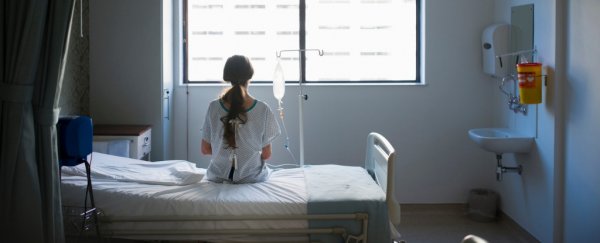From what we know so far, SARS-CoV-2 is most commonly spread person to person. But if there's anything the pandemic has taught us, it's to pay close attention to potential transmission from surfaces and other objects.
Microbiologists from University College London (UCL) have now found that even in hospital rooms designed for containment of COVID-19 risks, viruses can easily be transferred to other areas.
When viral DNA - one harmless to humans - was left on a hospital bed rail within a highly contained unit, it took fewer than ten hours to spread to nearly half the ward, sticking around for at least five days at these sites.
And that's only when one bed rail was the source. A patient infected with a coronavirus is very likely to cough, sneeze and spread the virus through touch to various surfaces and inanimate objects, putting others who touch these surfaces at potential risk.
"Our study shows the important role that surfaces play in the transmission of a virus and how critical it is to adhere to good hand hygiene and cleaning," says microbiologist Lena Ciric from UCL.
"Our surrogate [virus] was inoculated once to a single site, and was spread through the touching of surfaces by staff, patients and visitors."
It's important to note this experiment was not done to measure infection rates - only how quickly a virus can potentially spread if it is not cleaned from a surface, even in a high-containment area.
The plant-infecting virus used for this research can be easily removed by disinfecting a surface or by washing your hands, which is also true for the coronavirus that causes COVID-19. In fact, a single alcohol wipe can remove 98.88–99.84 percent of the surrogate virus the researchers used.
In this particular case, viral material was spread across a number of surfaces in an otherwise well maintained ward, highlighting a potential weakness in hygiene policies.
"As a high-risk area, the isolation room where the bed rail was inoculated had a different cleaning regimen to the rest of the ward," the authors write.
"However, its wide dissemination indicates cleaning failure. As the surrogate is removed readily with good hand hygiene, this also indicated hand hygiene failure."
Diluting the viral DNA of their harmless surrogate in water, researchers carefully dropped the material on the handrail of a bed in an isolation room reserved for the most infected. Each evening for the next five days, the team sampled 44 sites across the ward to see how far the sample had travelled.
After a mere ten hours, the surrogate genetic material had spread to 41 percent of sites, including bed rails, door handles, arm rests, and children's toys and books.
After three days, the number of sites contaminated peaked at 52 percent, falling to 41 percent two days later. Even by the end of the sampling period, the virus persisted.
The rooms closest to the original infection were the most contaminated. On day three, 86 percent of all clinical areas tested positive, and on day four, 60 percent of sites in the immediate bedspace area tested positive.
The authors argue the results imply a combination of poor cleaning, patients moving around, and a lack of proper hygiene from carers.
"People can become infected with COVID-19 through respiratory droplets produced during coughing or sneezing," says healthcare scientist Elaine Cloutman-Green from UCL.
"Equally, if these droplets land on a surface, a person may become infected after coming into contact with the surface and then touching their eyes, nose or mouth."
This situation is certainly possible, but how often it actually happens is still unclear. While previous research suggests the COVID-19 virus can stick around on cardboard for up to a day and on plastic and steel for up to 72 hours, there's little data on how large these viral loads are, or how dangerous.
The United States' Centers for Disease Control and Prevention (CDC) emphasises that while it might be possible to contract the coronavirus from touching a contaminated surface, it's not the most common form of transmission.
That said, it's still essential for healthcare workers to keep washing their hands and wiping down surfaces consistently to limit transmission as much as possible, especially since it's a relatively easy thing to do.
Unfortunately, however, these new findings suggest that even in hospitals with rigid hygiene practices, a virus can slip right past our defences. As the authors note in the title of their paper: we can't forget the surfaces.
The findings were published as a letter to the editor in the Journal of Hospital Infection.
